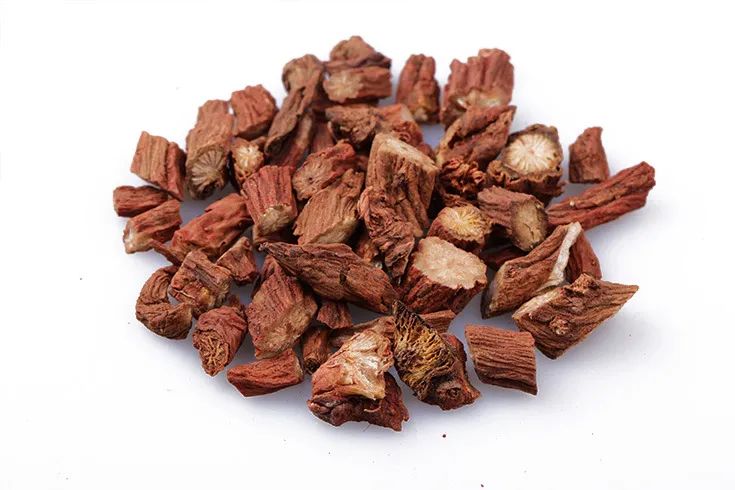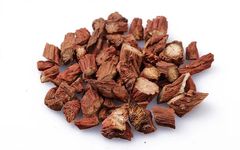Click the top left corner to follow us
Danshen


Plant Source
It is the dried root and rhizome of the plant Danshen (Salvia miltiorrhiza Bge.) from the Lamiaceae family. Other names include Honggen, Da Hong Pao, and Xue Shen Gen. Its effects include invigorating blood circulation, regulating menstruation, removing blood stasis and alleviating pain, cooling blood and resolving abscesses, and calming the mind. Its properties are bitter in taste, slightly cold in nature; it enters the Heart and Liver meridians. The characteristics of the herb are the rhizome is thick, sometimes with remnants of red-purple or gray-brown stem bases at the top. The roots are 1 to several, brick-red or reddish-brown, long cylindrical, straight or curved, sometimes branched with root hairs, 10-20 cm long, 0.2-1 cm in diameter, with longitudinal wrinkles and root hair marks on the surface; old roots have gray-brown or brown cork, often peeling in scales, exposing red-brown new cork, sometimes the bark cracks, revealing white wood. The texture is hard, easily broken, with an uneven fracture surface, either horn-like or fibrous. The cambium ring is distinct, the wood is yellow-white, and the vessels are radially arranged. It has a faint fragrance, a mild taste, and is slightly bitter and astringent. The shapes of the slices are as follows:1. Danshen: round thick slices, with a red-yellow or yellow-brown surface, scattered with white vein spots, slightly yellow in the center. The outer skin is dark red-brown, with a faint aroma, and a slightly bitter, astringent taste.2. Wine Danshen: similar to Danshen, with a yellow-brown surface and a slight wine aroma. 3. Fried Danshen: similar to Danshen, with a purple-brown surface and scorched spots. 4. Pig Blood Danshen: similar to Danshen, with a pig blood odor. 5. Turtle Blood Danshen: similar to Danshen, with a turtle blood odor. 6. Vinegar Danshen: similar to Danshen, with a rice vinegar taste. 7. Rice Danshen: similar to Danshen, with a deep purple surface. 8. Charred Danshen: similar to Danshen, blackened. Production Areas
1. Distributed in Hebei, Shanxi, Liaoning, East China, Henan, Hubei, Hunan, Sichuan, Guizhou, Shaanxi, Gansu, Ningxia, and other regions.
2. Most areas of the country have it. Mainly produced in Sichuan, Anhui, Jiangsu, Henan, Shanxi, and other places.
3. Grows on slopes, under forest grasslands, or by ditches at altitudes of 120-1300 m.


Performance Characteristics
Mainly used for irregular menstruation, amenorrhea, dysmenorrhea, postpartum stasis abdominal pain, blood stasis heart pain, abdominal pain, masses, trauma, rheumatic pain, sores, abscesses, and heat-related agitation and insomnia.
1. Irregular menstruation, amenorrhea, dysmenorrhea, postpartum stasis abdominal pain: It is effective in invigorating blood and removing stasis, slightly cold and gentle, can remove stasis and generate new blood without harming the normal state, and is commonly used in gynecology for regulating menstruation. The Compendium of Materia Medica states it “can break old blood and replenish new blood.” The Gynecological Theory mentions, “A single dose of Danshen powder has the same effect as the Four Substance Decoction.” Clinically, it is often used for irregular menstruation, amenorrhea, dysmenorrhea, and postpartum stasis abdominal pain. Due to its slightly cold nature, it is particularly suitable for blood heat and stasis conditions.
2. Blood stasis heart pain, abdominal pain, masses, trauma, rheumatic pain: This herb is good at promoting blood circulation, removing stasis, and alleviating pain, widely used for various blood stasis conditions.
3. Sores and abscesses: This herb is cold in nature, which can cool blood and invigorate blood, as well as clear heat and resolve abscesses.
4. Heat-related agitation and insomnia: This herb enters the Heart meridian, can clear heat and cool blood, calm agitation and settle the mind, invigorate blood and nourish blood to calm the mind and stabilize the spirit.
Clinical Applications
1. For blood heat and stasis conditions, combined with Chuanxiong (Chuanxiong Rhizome), Danggui (Angelica Sinensis), and Yimucao (Motherwort), such as Ningkun Zhibao Dan (from Health Treasure).
2. For cold coagulation and blood stasis, combined with Wuzhuyu (Evodia) and Rougui (Cinnamon).
3. For chest obstruction and heart pain due to blood stasis, abdominal pain, combined with Sharen (Cardamom) and Tanshan (Sandalwood), such as Danshen Decoction (from Golden Needle of Medicine).
4. For masses, can be combined with Sanleng (Sparganium) and Ezhong (Rhizoma Curcumae).
5. For trauma and pain due to blood stasis, often used with Danggui, Ruxiang (Frankincense), and Moyi (Myrrh), such as Huoluo Xiaoling Dan (from Medicine in the West and East).
6. For rheumatic pain, can be combined with Fangfeng (Siler) and Qinjiao (Gentiana) to dispel wind and eliminate dampness.
7. For sores and abscesses caused by heat toxin and stasis, often combined with heat-clearing and detoxifying herbs.
8. For early-stage breast abscess, can be used with Jinyinhua (Honeysuckle) and Lianqiao (Forsythia), such as Xiaon乳汤 (from Medicine in the West and East).
9. For agitation and insomnia due to heat entering the Heart and Ying, can be combined with Shengdihuang (Rehmannia), Xuan Shen (Scrophularia), Huanglian (Coptis), and Zhuye (Bamboo Leaf).
10. For insomnia and palpitations due to blood not nourishing the heart, often used with Shengdihuang, Suanzaoren (Sour Jujube Seed), and Baiziren (Platycladus), such as Tianwang Buxin Dan (from Secret of Life).
Related Combinations
1. Danshen combined with Guizhi (Cinnamon Twig): Danshen is good at invigorating blood and removing stasis; Guizhi helps to warm Yang and open the meridians. Together, they warm Yang, invigorate blood, and alleviate pain, suitable for chest pain and palpitations due to Yang deficiency and blood stasis.
2. Danshen combined with Gegen (Pueraria): Danshen is effective in invigorating blood and removing stasis, while Gegen helps to lift and release, clear heat, and generate fluids. Together, they enhance the effects of invigorating blood, removing stasis, and generating fluids, suitable for Yin deficiency with stasis.
3. Danshen combined with Gualou (Trichosanthes): Danshen invigorates blood and cools blood, reduces swelling and alleviates pain, while Gualou clears heat and transforms phlegm, disperses masses and resolves abscesses. Together, they treat heat toxin stagnation causing breast abscesses, redness, swelling, and pain.
4. Danshen combined with Sharen: Danshen is good at invigorating blood and removing stasis; Sharen is good at promoting Qi and unblocking the middle. Together, they significantly alleviate pain caused by blood stasis and Qi stagnation.
5. Danshen combined with Ren Shen (Ginseng): Danshen invigorates blood and removes stasis, while Ren Shen greatly tonifies Yuan Qi and nourishes blood. Together, they nourish blood and invigorate blood, and promote the generation of Qi and blood, suitable for palpitations, chest tightness, chest pain, or irregular menstruation due to Qi deficiency and blood stasis.
Distinguishing Medicinal Uses
1. Raw Danshen vs. Wine Danshen: Raw Danshen has stronger effects in removing stasis and alleviating pain, calming the heart and mind, and invigorating blood and regulating menstruation. Due to its cold nature, it is often used for sores, postpartum stasis pain, amenorrhea, abdominal pain, and limb pain caused by blood heat and stasis. Wine Danshen, being processed, has a milder cold nature, enhancing its effects in invigorating blood, removing stasis, and regulating menstruation, often used for blood stasis causing amenorrhea, dysmenorrhea, irregular menstruation, postpartum lochia retention, chest pain, masses, and trauma.
2. Danshen vs. Xuan Shen: Both herbs are named ‘Shen’ and are cold in nature, both have heat-clearing properties and can be used for heat conditions. However, Danshen excels in invigorating blood, regulating menstruation, cooling blood, resolving abscesses, and calming the mind, mainly treating blood stasis causing irregular menstruation, dysmenorrhea, amenorrhea, chest and abdominal pain, masses, rheumatic pain, trauma, sores, heat-related agitation, and insomnia. Xuan Shen excels in clearing heat, cooling blood, nourishing Yin, and detoxifying, mainly treating warm toxin causing rashes, fluid damage leading to constipation, sore throat, scrofula, and abscesses.
3. Danshen vs. Chuanxiong: Both herbs invigorate blood and remove stasis, and can be used for blood stasis causing amenorrhea, dysmenorrhea, irregular menstruation, postpartum stasis abdominal pain, chest pain, masses, and trauma. However, Danshen can invigorate and cool blood, particularly suitable for blood heat and stasis. Chuanxiong is warm and dispersive, suitable for Qi stagnation and blood stasis.
4. Danshen vs. Yujin: Both herbs are cold blood-invigorating and stasis-removing herbs, and can be used for blood stasis and abnormal mental states. However, Danshen excels in invigorating blood and removing stasis, and can nourish blood and calm the mind, suitable for blood heat and stasis, and blood deficiency with mental unrest. Yujin excels in invigorating blood and promoting Qi, and can cool blood and clear the heart, suitable for Qi stagnation and blood stasis causing mental confusion.
5. Danshen vs. Danggui: Both herbs invigorate blood and remove stasis, and can be used for blood stasis and rheumatic pain. However, Danshen is slightly cold, suitable for blood heat and stasis, and rheumatic heat with blood stasis. Danggui is warm, suitable for blood deficiency with stasis, and wind-cold-dampness with blood stasis.

 Related Discussions
Related Discussions
1. Rihua Zibencao: “Nourishes blood and calms the mind, regulates joints, treats cold and hot labor, bone and joint pain, and paralysis of the limbs; relieves distension and pain, promotes muscle growth; breaks old blood and replenishes new blood; calms pregnancy and expels dead fetus; stops bleeding, regulates women’s menstruation, relieves heart vexation; treats sores, scabies, goiter, and abscesses; headaches, red eyes; heat-related agitation.”
2. Materia Medica Bian Du: “Danshen, has the same effect as the Four Substance Decoction, can remove stasis to generate new blood, is good for treating wind and dispersing masses, is neutral in nature and moves blood… Its taste is sweet and bitter for regulating menstruation, but it mainly opens the Ying level. Although Danshen has ‘Shen’ in its name, its blood-nourishing power is insufficient, while its blood-invigorating power is abundant, making it the primary herb for regulating blood levels. Its ability to treat wind and remove masses is also due to blood movement leading to the resolution of wind and masses.”
Related Medicines/ Formulas1. Compound Danshen Dripping Pills (granules, tablets), Baoxin Tablets, Dantian Lipid-lowering Pills, Tongmai Granules, Naozhending Granules.2. Danshen Powder (from Women’s Good Prescription), Danshen Decoction (from Song of Current Formulas), Xiaon乳汤 (from Medicine in the West and East).Dosage
Internal use: decoction, 5-15g; for invigorating blood and removing stasis, it is better to use wine-fried.
External use: none.
Precautions
Women with excessive menstruation and no blood stasis should avoid use; pregnant women should use with caution; contraindicated with Li Lu.
Adverse Reactions/ Contraindications
1. If Danshen is used in excessive amounts, or improperly, or in allergic individuals, it may lead to toxicity.
2. Symptoms of toxicity mainly include dry mouth and throat, nausea, vomiting, stomach pain, and reduced appetite. If allergic reactions occur, symptoms may include generalized skin itching, rashes, urticaria, and in some cases, chest tightness, difficulty breathing, chills, dizziness, nausea, vomiting, agitation, followed by pale complexion, cold limbs, sweating, decreased blood pressure, and even fainting or shock.
3. Upon occurrence of toxic side effects, immediately discontinue Danshen, and take oral medications such as Weishu Ping, Prubenshin, etc. In severe cases, subcutaneous injection of atropine may be required. If upper gastrointestinal bleeding occurs, hemostatic agents, vitamins, Da Huang powder, or Sanqi powder should be administered. In case of allergies, immediate intramuscular injection of epinephrine or dexamethasone, as well as antihistamines like Fenatadine should be given.
1. Contraindications for herbal combinations: contraindicated with Li Lu.
2. Contraindications for combinations with Western medicines:
(1) Should not be combined with aluminum hydroxide or cytochrome C injection, as it may form complexes that affect absorption.
(2) Danshen can promote the metastasis of malignant tumors, so it should not be used with chemotherapy drugs such as cyclophosphamide, fluorouracil, and cytarabine.
(3) When used with antacids, it can form chelates, reducing the bioavailability of Danshen and affecting its efficacy.
(4) Danshen should not be used with atropine, as atropine can block the hypotensive effect of Danshen.
(5) Danshen injection mixed with vitamin C can undergo redox reactions, leading to a reduction or disappearance of their effects.
(6) When used with Western anticoagulants, sedatives, and anesthetics, the dosage should be reduced.
3. Dietary contraindications: avoid vinegar and acidic foods.

Medicinal Diet Therapy



Warming Meridian Danshen Tea: 1. Efficacy: It has the effects of tonifying Qi and nourishing blood, warming the meridians, and invigorating blood, which is very helpful for women with irregular menstruation symptoms. 2. Ingredients: 15 grams of Danshen, appropriate amount of brown sugar, 150 milliliters of water. 3. Method: Rinse Danshen slightly, place it in a pot, add water and decoct. When about 100 milliliters of water remains, remove Danshen, and add an appropriate amount of brown sugar according to personal taste, stirring well. 4. Usage: Drink freely, but those with excessive heat and bleeding should avoid it.
Methods of using Chinese medicine vary from person to person; please follow medical advice before use.

End




